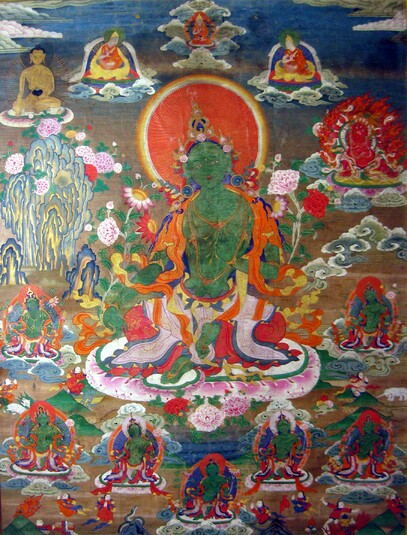
Item: Tara (Buddhist Deity) - Green
| Origin Location | Tibet |
|---|---|
| Date Range | 1800 - 1899 |
| Lineages | Gelug and Buddhist |
| Material | Ground Mineral Pigment on Cotton |
| Collection | Private |
Classification: Deity
Appearance: Peaceful
Gender: Female
Tara, Green Protecting from the Eight Fears, accompanied by three figures of Gelug teachers, Shakyamuni Buddha and 'Secret Accomplishment' Hayagriva. (See the Tara Main Page and the Outline Page).
Tibetan: drol ma jang ku
"On an and eight petaled lotus...is Holy Tara, reddish-green in colour, one face and two hands. The right [hand] is in the gesture of supreme generosity and the left holds with the thumb and ring finger a lily to the heart. Wearing beautiful jewel ornaments and various silks, the hair as a crown, seated in a posture with the right leg extended and the left drawn up." (Thartse Panchen Namka Chime).
Dark green in colour, she has one face and two hands. The palm of the right hand is in the mudra (gesture) of supreme generosity holding the stem of a lotus - blossoming above the shoulder. Held to the heart, the left thumb and forefinger hold pink and red blossoms. Peaceful, smiling and youthful she is adorned with flowing silks of various colours and jewel ornaments, gold tiara and the like; seated with the proper right leg slightly extended in a relaxed manner and the left drawn up.
At the top of the composition are three figures wearing monastic robes and the yellow pandita hats of the Gelug Tradition. On the left side is Shakyamuni Buddha, gold in colour, possibly imitating the the Jowo sculpture in the Lhasa Cathedral. On the right side is 'Secret Accomplishment' Hayagriva, red in colour with three faces and six hands.
In the lower composition and surrounding the lotus seat of the central Tara are seven further Taras, all green, all identical in form to the central figure. As a group they represent the Eight Taras Protecting from the Eight fears. Individually and beginning with the central Tara, moving clockwise, they represent protection from Wrongful Imprisonment, Elephants, Bandits, Ghosts, Water, Snakes, Fire, and Lions. A depiction of each object of fear is found below each of the Tara forms. For the central large Tara, at the left side of the pink lotus seat is a small kneeling figure with a length of blue-grey metal chain placed in front. The human figure and the chain represent false imprisonment.
These eight: (1) water, (2) lions, (3) fire, (4) snakes, (5) elephants, (6) thieves, (7) false imprisonment and (8) ghosts are meant literally, but also have a deeper significance. Tantric Buddhism commonly presents an interpretive model having three and sometimes four levels of meaning: 1. Outer, 2. Inner, and 3. Secret. The outer meaning of the eight fears are exactly as described above which are real fears experienced in ancient times and even now in the present day world. They all relate to the physical person and the fears presented in a physical material world. The inner meaning relates to passions, ego and negative emotional characteristics. The inner meaning relates to the mental world. The secret meaning has to do with tantric techniques and philosophies to transform these negative mental states into enlightened Buddhist states. (See the Eight Fears Outline).
From Indian sources Tara is a completely enlightened buddha who had previously promised to appear, after enlightenment, in the form of a female bodhisattva, goddess-like, for the benefit of all beings. In one Tibetan tradition, based on the apocryphal text called the Mani Kabum, Tara is described as emanating as a tear from the form of Avalokiteshvara with eleven heads and one thousand hands.
Practiced in all Schools of Tantric Buddhism her various forms are also found in all four classifications of tantra, both Nyingma and Sarma. Her ten syllable mantra and the short tantra text known as the 'Twenty-One Praises of Tara' spoken by the buddha Samantabhadra are memorized and popularly recited by all Tibetans from the time of early childhood. Her primary activity is to protect from the eight and sixteen fears.
Tara is a completely enlightened buddha and having promised to appear in the form of a female bodhisattva and goddess for the benefit of all beings she especially protects from the eight fears. Practiced in all Schools of Tibetan Buddhism Tara is second in popularity only to Avalokiteshvara. Her practices are found in all classes of tantra - Nyingma and Sarma.
Jeff Watt 2-2011
Buddhist Deity: Tara Main Page
Buddhist Deity: Tara, Eight Fears
Collection of WGA
